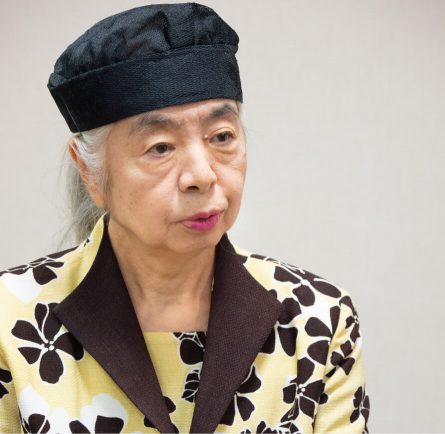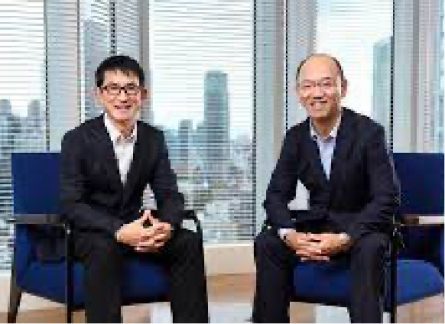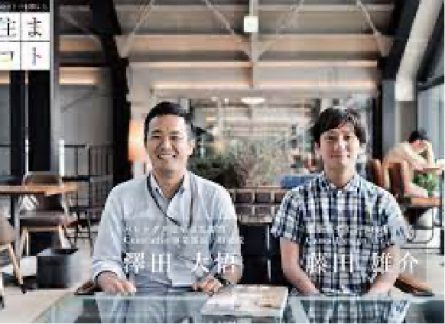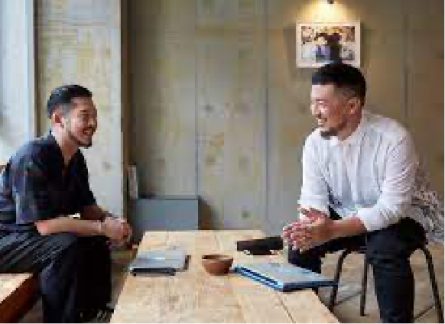Interview article
対談記事

「長岡先生のかすれは本当に美しいですね」
ハイケ・イェローミン(以下ハイケ):長岡先生とは、2019年春の日欧宮殿芸術祭(ウィーン)以来となりますね。お久しぶりです。あの時は素晴らしい揮毫を披露していただき、ありがとうございました。今日は先生の書の創作についてお伺いしたいと思います。まず、今回お持ちいただいた「匂」についてお聞かせください。
長岡美和子(以下長岡):こちらの「匂」という字は、「漂」にも意味の通じるところがありますね。花の香りのような嗅覚を刺激するものではなく、気配とか、存在とかを示すような意味合いも兼ねていると。この作品、題材を三浦朱門の「冥府山水図」からとった作品で、物語は、山水画の絵師たちが、絶景を求めて山の奥深くまで分け入っていく苦悩が語られていまして、多くの絵師が険しさに挫折する中で、遂に絶景に到達した絵師の一人がそれを描くのだけれども、実物の素晴らしさにはまったく及ばないことを思い知らされるんですね。そして最後にはその絵師も息絶えて土に還り、匂いくらいしか残らないと。

キャプションキャプションキャプションキャプションキャプション
ハイケ:それで、「匂」が出てきたのですね。それは小説の中に、実際に使われている字なのですか?
長岡:えぇ、ページの中から、最も物語を象徴する字が、読んでいるうちにスッと浮かび上がってくるんです。これは、私が長年手がけている表現のスタイルで、これ以外にも様々な本をテーマにして、書を表してきました。
ハイケ:とてもインテリジェンスがあり、魅力的な表現ですね。私は長岡先生の書を見て、とくにかすれが美しいと感じました。このかすれの表現というのは、どうやって書いて、どのように違いを作り出すのでしょうか?
長岡:書き方、筆遣いはもちろんですが、墨の質による違いが大きいと思います。硯で墨を擦る時に力を加えれば濃くなりますし、粘り気も強くなる。水の配分で薄くなったり、紙への浸透の仕方も変わってきますね。そもそも墨自体も、純粋な黒とは違いますから、物によって擦った時、水を入れた時の色の具合が変わってきます。鼠色ということもありますが、それはあくまで墨の色のほんの一面に過ぎません。それを、筆一本で書き切っていくわけです。
ハイケ:それを実際にできるようになるには、多くの経験が必要ですよね。
長岡:仰るとおりです。例えば私が作品を書くのに使う筆は、非常に穂の部分が長く、全体に墨をしっかりと行き渡らせてから書き始めます。含まれた墨だけで最後まで書き切るため、穂全体を使わないように気を配りながら進めていくんです。ただ、べたべたに墨を漬け過ぎてもいけません。ちょうど使い切れる量を、適度に筆先に落としながら書けるようになるには、とにかく数多く書いて覚えるのが大切です。
ハイケ:ウィーンで見た揮毫で思ったのが、体の動きが武術の居合道のようだということです。先生は居合道をやっているとお聞きしましたが、書に活かされることなどはありますか?
長岡:書道は全身を使って書いていきますから、その点では共通します。ただし居合道でなくとも、合気道や剣道など、武術は細かな技術こそ違いますが、呼吸法など根っこの部分では同じであり、それは書道にも必要なことですね。
ハイケ:実は先生お会いするにあたり、墨象についても学びました。墨象は中国の書にはない日本独自の書芸術であり、アメリカの抽象表現やアクションペインティングにも影響を与えるなど、すでに世界基準のアートとなっています。そして、その分野で優れた成果を残している長岡先生とお会いして、改めてそのすごさを実感しました。今日も色々と教わりましたが、やはりかすれの美しさですね。本当に感激しました。ぜひこれからも素晴らしい書の世界を表現してください。
長岡:ありがとうございます。個人的にもかすれのある書は好きなのです。なぜなら、難しいから。難しい方が面白いじゃないですか。
ハイケ:素晴らしい。そのお気持ち、まさに本物の芸術家だと思います。
“The blur effect of Nagaoka’s work is truly beautiful”
Heike Jeromin (hereinafter referred to as “Heike”): Ms. Nagaoka, this is the first time I’ve seen you since the Spring 2019 Japan-Europe Palace Art Festival (Vienna). So it’s been a while. Thank you for showing me your work during that time. As for today, I’d like to ask you about the creation of your calligraphy work. So please start off by telling me about the “Scent” piece that you brought with you today.
Miwako Nagaoka (hereinafter referred to as “Nagaoka”): In a sense, the word “scent” here can be interpreted to mean “drift.” The word does not refer to the way one’s sense of smell is stimulated by something such as the fragrance of a flower. It does, however, contain the nuance of being an indicator of a “sign” or “presence.” This piece takes on the theme of a short story by Shumon Miura titled “The Landscape of Mountain.” The piece tells a story of the grievances faced by landscape painters who travelled deep into the mountains in search of a picturesque view. While many painters suffered setbacks due to the harsh nature of the journey, there was one painter who was able to find this picturesque view and painted it at last. However, he then realized that his painting was never going to live up to the true splendor of the actual scenery. So in the end, the painter took his last breathe and was buried back into the soil, leaving nothing but a scent.

texttexttexttexttexttexttexttexttexttext
Heike: So that’s how the “Scent” piece came into being. But was the “scent” character actually used in the novel?
Nagaoka: Yes. It was the most symbolic character within the pages of the story. It popped out to me immediately as I was reading. This is also a style of expression that I’ve worked on for many years. Besides this, I’ve also done other calligraphy pieces where I’ve used a variety of books as the theme.
Heike: It’s a very smart and captivating form of expression. When I looked at your works, I felt that the blur effect was especially beautiful. So how do you create these blurs and how do you make them different from one another?
Nagaoka: Using different writing techniques and changing my brushwork definitely allows me to alter the appearance of the blur. But I think it also differs greatly depending on the quality of the ink. If I apply force when rubbing the ink against the inkstone, the ink will become dark and sticky as a result. But when I mix the ink with water, it becomes diluted, which also changes the way the ink seeps into paper. The ink itself is not purely black by nature, so the color I get when rubbing it against something will differ from the color I get when it’s mixed with water. There’re also times when the ink is grey. But that’s nothing more than just one of the aspects of the ink’s color. It’s something that can be produced on paper with just a single brush.
Heike: To be able to do this actually requires a lot of experience, doesn’t it?
Nagaoka: You’re absolutely right. For instance, the brush I use to write my calligraphy pieces has to have a very long tip. Plus I’m only able to begin writing after I’ve thoroughly spreaded the ink throughout the brush tip. I also have to complete the calligraphy piece in one go with only the ink that’s on the brush. Because of this, I have to be mindful not to use all the ink on the brush tip as I’m writing. But at the same time, I also have to make sure not to use too much ink and not to make it sticky. It’s important to practice many times over when learning how to use just the right amount of ink to finish a piece and to learn how to write while using the moderate amount of ink on the brush tip.
Heike: When I saw your work in Vienna, the thought that came to mind was that the movement of the body is like the martial art of iaido. I heard that you’re doing iaido. But do you ever apply anything from iaido into your calligraphy work?
Nagaoka: Calligraphy is similar to iaodo in that it requires the whole body to be used. But other than iaido, martial arts such as aikido and kendo all differ from each other in terms of the detailed techniques used. Despite this, they’re also the same as each other at a base level, since they share certain qualities that are the same such as breathing techniques. This sort of thing is also necessary in calligraphy.
Heike: Actually, when I met you, I also learned about the practice of bokusho (ink images). Bokusho is a form of calligraphy that is unique to Japan and unseen in Chinese calligraphy. It has already become a world-standard form of art that influences abstract expressions and action paintings in America. Also, after meeting a person like you who has accomplished great achievements in the field, I once again felt how wonderful the art form is. I learned a lot from you today, but I was truly moved by the beauty of the blur effect. So please continue to portray the wonderful world of calligraphy from now on.
Nagaoka: Thank you very much. I personally like calligraphy pieces with the blur effect too. Because it’s difficult to achieve. Isn’t it more interesting when something is difficult?
Heike: That’s great. Hearing you say that makes me think that you’re indeed a true artist.





